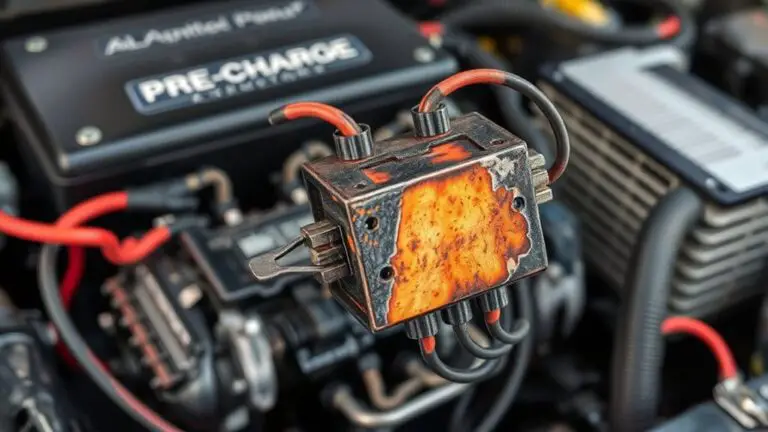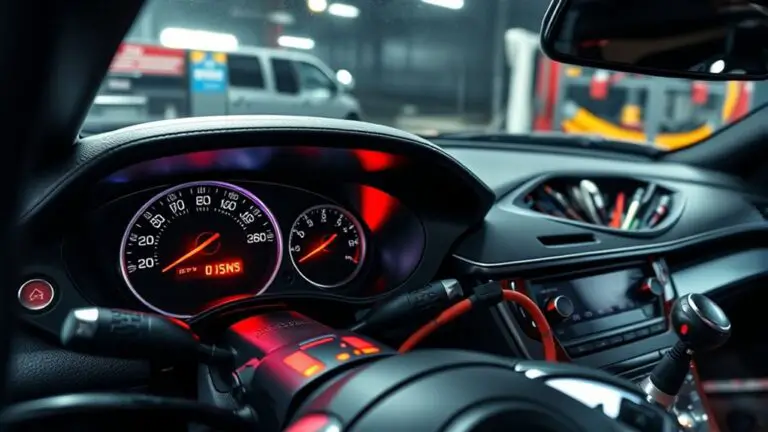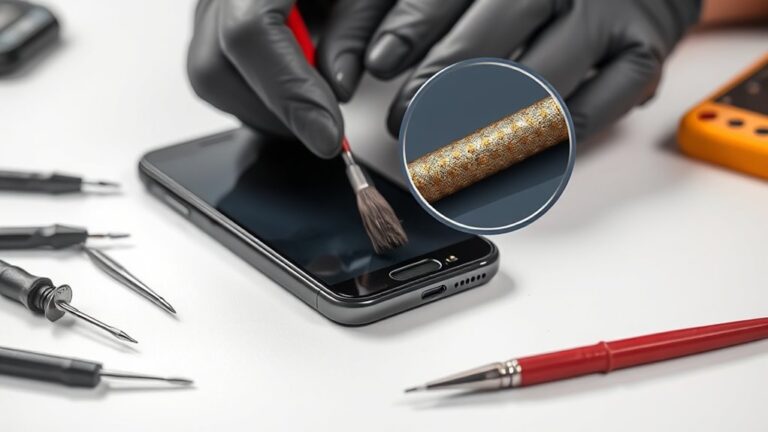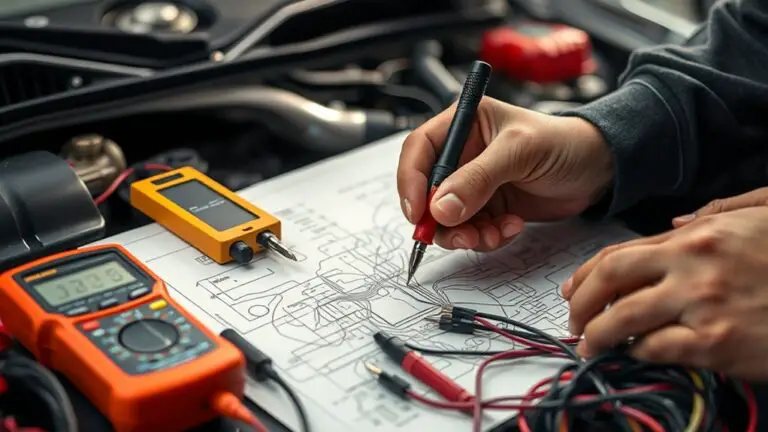When Bad Ground Mean It’s Time for a New Ignition Switch
When you notice symptoms like flickering dashboard lights, intermittent starting, or unusual clicking sounds, it may indicate bad ground connections in your ignition system. These issues often point to a malfunctioning ignition switch. If left unaddressed, this can lead to more severe problems and potential safety risks. It is crucial to investigate these signs promptly. By understanding the nuances of ignition system failures, you can better maintain your vehicle’s reliability and safety.
Understanding the Role of the Ignition Switch

The ignition switch is a crucial component in your vehicle’s starting system. It serves as the gateway to the ignition circuit, allowing electrical current to flow from the battery to the ignition system. When you turn the key, you’re not just activating the starter; you’re engaging a series of contacts that must manage electrical resistance efficiently. A high resistance in this circuit can lead to insufficient power delivery, preventing your engine from starting.
In essence, the ignition switch guarantees that the right amount of voltage reaches the ignition system, enabling combustion in the engine. If this component fails, it can disrupt the entire starting process, leading to frustration and inconvenience. By understanding its role, you can appreciate why maintaining a functional ignition switch is essential for your vehicle’s performance and your freedom on the road. Keep an eye on your ignition circuit to guarantee a reliable driving experience.
Common Symptoms of a Failing Ignition Switch
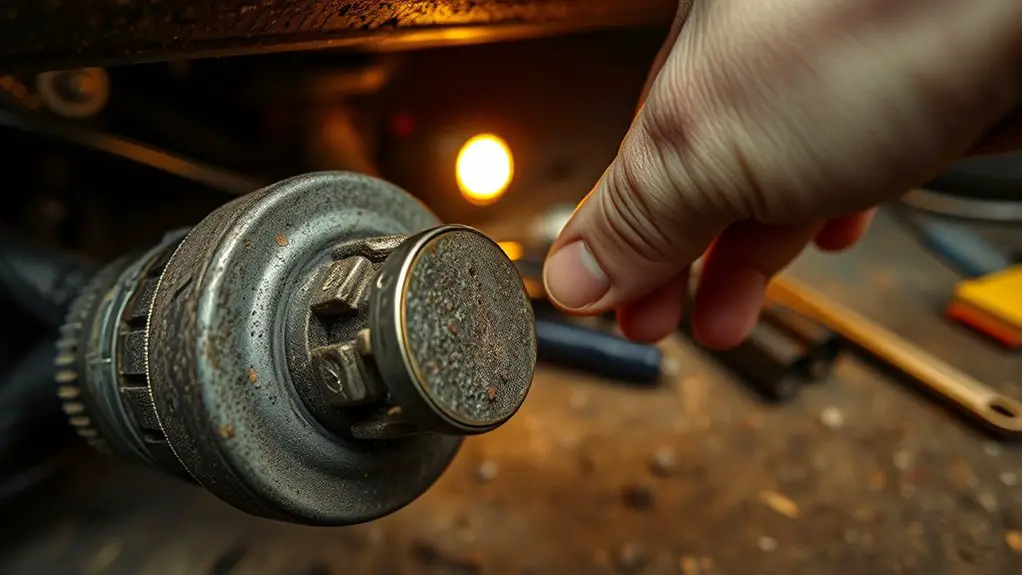
If your engine won’t start or you’re experiencing electrical issues, it could indicate a failing ignition switch. These symptoms often stem from poor connectivity or internal wear within the switch. Recognizing these signs early can help you address the problem before it leads to more significant vehicle issues.
Engine Won’t Start
When your engine won’t start, one of the potential culprits could be a failing ignition switch. In engine troubleshooting, it’s vital to understand that the ignition switch plays a key role in activating the starter motor. If you turn the key and hear nothing, or the engine cranks inconsistently, the ignition switch may not be delivering power to the starter motor. Additionally, if dashboard lights flicker or fail to illuminate, this could signal an issue with the switch. It’s important to rule out other components like the battery and starter before concluding that the ignition switch is to blame. Addressing this problem promptly can save you time and guarantee you regain your freedom on the road.
Electrical Issues Present
How can you tell if your ignition switch is failing? You might experience electrical issues like flickering dashboard lights or intermittent power loss to accessories. These symptoms often indicate poor connections within the ignition switch. Conducting electrical diagnostics can help pinpoint the problem. If you notice that your vehicle’s electrical components aren’t functioning consistently, it’s time for ground testing. A failing ignition switch can disrupt the flow of electricity, leading to these erratic behaviors. Additionally, you may find that your car stalls unexpectedly or has difficulty starting, both of which can stem from ignition switch failure. Addressing these issues promptly can enhance your vehicle’s reliability and restore your freedom on the road.
The Impact of Bad Ground Connections

Although bad ground connections may seem minor, they can greatly disrupt a vehicle’s electrical system, leading to issues such as erratic starting or complete failure of the ignition switch. Ground connections play an essential role in electrical grounding, ensuring that circuits function properly. When these connections deteriorate, it creates resistance that interferes with the flow of electricity. This can result in inconsistent power delivery to critical components, affecting performance and reliability.
You might notice flickering lights or misfiring engines; these are signs that electrical grounding has been compromised. Ignoring these symptoms can lead to more severe problems, potentially leaving you stranded. To maintain your vehicle’s freedom and reliability, regular inspections of ground connections are indispensable. Addressing bad ground connections promptly not only enhances performance but also extends the lifespan of your ignition switch and other electrical components. Don’t take them lightly; they’re essential to your vehicle’s health.
Diagnosing Electrical Issues in Your Vehicle
When diagnosing electrical issues in your vehicle, it’s essential to recognize common symptoms like flickering lights or unresponsive accessories. Testing electrical connections can help pinpoint the source of the problem, ensuring you address any faulty wiring or ground issues effectively. By understanding these aspects, you can prevent further complications and maintain your vehicle’s reliability.
Common Symptoms Explained
Electrical issues in your vehicle can manifest through various symptoms, making diagnosis essential for effective repairs. Recognizing these symptoms can save you time and money. Here are some common signs to look for:
- Difficulty starting: You may notice your engine struggles to turn over or fails to start altogether.
- Dashboard warning lights: Unusual lights may indicate problems with the ignition switch or other electrical components.
- Flickering lights: If your headlights or interior lights flicker, it could point to faulty connections or bad ground.
- Electrical accessories malfunctioning: If windows, locks, or radios act erratically, it’s often a sign of ignition switch issues.
Keep these troubleshooting tips in mind to address ignition switch types effectively and maintain your vehicle’s electrical integrity.
Testing Electrical Connections
Identifying symptoms like difficulty starting or dashboard warning lights often leads to the need for a thorough inspection of electrical connections. Start with basic electrical troubleshooting techniques, such as visual inspections for damaged wires and loose terminals. Use a multimeter to check voltage levels across connections, guaranteeing they meet manufacturer specifications. Pay special attention to ground connections, as poor grounding can disrupt the entire electrical system. If you find inconsistencies, it’s vital to clean or replace corroded terminals. Additionally, test continuity between components to confirm that electrical pathways are intact. By systematically applying these testing techniques, you can pinpoint issues and guarantee your vehicle’s electrical system operates reliably, giving you the freedom and confidence to drive.
Signs of Bad Ground in Your Ignition System
How can you tell if your ignition system is suffering from a bad ground? Identifying these signs early can save you from more significant issues down the line. Here are some key indicators:
- Flickering Dashboard Lights: If your dashboard lights flicker when you turn the key, it may signal a bad ground connection.
- Intermittent Starting Issues: Difficulty starting your vehicle or having it stall can indicate grounding problems within your ignition system.
- Unresponsive Accessories: If electrical accessories fail to work properly, it’s a strong sign that your ignition system might not be grounded correctly.
- Strange Noises: Unusual clicking or buzzing sounds when attempting to start your car can stem from a bad ground.
These symptoms suggest that the bad ground in your ignition system needs immediate attention. Addressing these issues promptly can enhance your vehicle’s performance and reliability.
How a Faulty Ignition Switch Affects Your Car
A faulty ignition switch can lead to several symptoms of ignition failure, including unexpected stalling and difficulty starting your engine. These issues not only compromise your vehicle’s performance but also pose significant safety risks while driving. To accurately diagnose the problem, a systematic testing process is essential to determine the switch’s functionality.
Symptoms of Ignition Failure
Ever wonder what signs indicate a failing ignition switch? Recognizing these symptoms is essential for effective ignition troubleshooting and timely switch replacement. Here are four key indicators you shouldn’t ignore:
- Engine Stalling: If your engine unexpectedly dies, it may signal ignition switch failure.
- No Start Condition: Turning the key yields no response—this can indicate a faulty connection within the ignition system.
- Intermittent Electrical Issues: Flickering dashboard lights or malfunctioning accessories often point to ignition problems.
- Difficulty Turning the Key: If the key feels stuck or hard to turn, it may indicate wear in the ignition switch.
Being aware of these symptoms can empower you to address ignition issues before they escalate. Stay informed and keep your freedom on the road.
Safety Risks Involved
Ignoring the signs of a failing ignition switch can lead to serious safety risks while driving. A faulty switch can unexpectedly cut power to your vehicle, disabling essential systems like steering and brakes, putting you and others at risk. You may also experience unintended engine shutdowns, which can occur at pivotal moments, such as merging into traffic. To guarantee ignition safety, it’s vital to implement safety precautions like regular inspections and addressing any warning signs promptly. Furthermore, a malfunctioning switch can lead to increased vulnerability to theft, compromising your vehicle’s security. Prioritizing the health of your ignition system not only enhances your driving experience but ultimately safeguards your freedom on the road. Don’t underestimate the importance of a reliable ignition switch.
Diagnostic Testing Process
While you might not notice the subtle signs of a faulty ignition switch immediately, diagnostic testing is crucial for identifying how such a malfunction can impact your vehicle’s performance. Using the right diagnostic tools and testing methods can pinpoint issues precisely. Here are four key steps involved in the process:
- Visual Inspection: Check for any obvious signs of damage or wear on the ignition switch and surrounding components.
- Voltage Testing: Measure the voltage output to ascertain it’s within the manufacturer’s specifications.
- Continuity Testing: Use a multimeter to verify the switch is functioning correctly when turned.
- Scan Tool Analysis: Utilize an OBD-II scanner to retrieve any error codes related to ignition issues.
Understanding these steps can empower you to address ignition switch concerns effectively.
Testing Your Ignition Switch for Malfunctions
To guarantee your vehicle starts reliably, it’s essential to test your ignition switch for malfunctions, as even minor issues can lead to significant problems. Begin with basic ignition troubleshooting to assess switch performance. You can perform a simple voltage test using a multimeter to verify proper power flow through the switch.
Here’s a quick reference table for testing:
| Test Type | What to Check | Expected Outcome |
|---|---|---|
| Voltage Test | Measure voltage at the switch | Should match battery voltage |
| Resistance Test | Check continuity across terminals | Should show low resistance |
| Cranking Test | Observe behavior while cranking | Should engage without delay |
If any of these tests indicate a fault, your ignition switch may require further evaluation or replacement. Regular testing helps maintain your vehicle’s freedom and reliability.
Steps to Replace a Faulty Ignition Switch
Replacing a faulty ignition switch requires careful attention to detail to confirm proper installation and functionality. Follow these replacement steps to guarantee a successful process:
Replacing a faulty ignition switch demands precision to ensure proper installation and reliable functionality.
- Disconnect the Battery: Always start by disconnecting the negative terminal to prevent electrical shock or short circuits.
- Remove the Steering Column Cover: Carefully detach any screws or clips holding the cover in place to access the ignition switch.
- Unplug the Old Ignition Switch: Disconnect the wiring harness from the faulty ignition switch, noting the arrangement for reinstallation.
- Install the New Ignition Switch: Securely connect the new switch, ensuring the alignment is correct before replacing the steering column cover.
Preventing Future Issues With Your Ignition System
After addressing a faulty ignition switch, it’s important to contemplate ways to prevent future issues with your ignition system. First, follow ignition maintenance tips, such as regularly inspecting wiring for wear and corrosion. Ensuring clean, secure connections can greatly reduce the risk of faults.
Next, practice electrical safety by disconnecting the battery before performing any maintenance. This simple step can prevent shorts and injuries.
Additionally, keep your vehicle’s battery charged and in good condition, as weak batteries can strain the ignition system. Regularly checking fuses and relays for integrity is also essential; replace any that show signs of damage.
Lastly, consider investing in a quality surge protector for your vehicle’s electrical system to safeguard against power spikes. By adopting these strategies, you’ll not only extend the life of your ignition system but also enhance your overall driving experience.
When to Seek Professional Help for Ignition Problems
How can you tell when it’s time to seek professional help for ignition problems? Ignition issues can often be resolved with DIY troubleshooting techniques, but certain signs indicate that it’s time to call in the pros. Here are four key indicators:
- Frequent Failures: If your ignition system fails to start multiple times, it’s a sign of deeper issues.
- Electrical Smells: Burning odors or smoke suggest serious electrical problems that require immediate attention.
- Dashboard Warning Lights: Persistent warning lights related to the ignition system indicate that professional repair options should be considered.
- Unusual Noises: Grinding or clicking sounds when attempting to start can signal mechanical failure.
When faced with these signs, it’s vital to prioritize your safety and vehicle integrity. Seeking professional help can guarantee accurate diagnostics and effective repairs, allowing you to regain the freedom of the open road.
Frequently Asked Questions
Can a Bad Ignition Switch Drain My Car Battery?
A bad ignition switch can indeed drain your car battery, like a leaky faucet slowly emptying a bucket. If you’re experiencing ignition symptoms, such as flickering lights or difficulty starting, it might signal underlying battery issues. When the switch malfunctions, it can keep electrical components running even when the engine’s off, leading to a drained battery. To reclaim your freedom on the road, addressing this issue promptly is essential.
How Long Does It Take to Replace an Ignition Switch?
Replacing an ignition switch typically takes about 1 to 2 hours, depending on the vehicle and ignition switch types. You’ll want to take into account the complexity of your car’s electrical system and any potential additional work involved. Replacement costs can vary widely, ranging from $100 to $400, including parts and labor. Always guarantee you use a quality replacement to maintain your vehicle’s performance and reliability, giving you the freedom to drive without concerns.
Will a Faulty Ignition Switch Affect My Car’s Security System?
Yes, a faulty ignition switch can definitely affect your car’s security system. When ignition problems arise, it may disrupt the communication between the key fob and the vehicle’s security features, potentially preventing the system from recognizing your key. This can lead to issues like false alarms or failure to start. To guarantee your car’s security functions properly, addressing ignition problems promptly is essential, as neglect can compromise your vehicle’s overall safety.
Can I Drive With a Malfunctioning Ignition Switch?
You shouldn’t drive with a malfunctioning ignition switch. Imagine the thrill of freedom versus the peril of ignition issues; it’s a stark contrast. Ignition problems can lead to your car stalling unexpectedly, jeopardizing your driving safety. While you might think you can manage, the risks far outweigh the temporary convenience. It’s best to address these issues promptly to guarantee your vehicle operates reliably, letting you enjoy the open road without worry.
What Tools Are Needed to Replace an Ignition Switch?
To replace an ignition switch, you’ll need several essential tools. Grab a socket set for removing bolts, a flathead screwdriver to help pry off covers, and a torque wrench for securing the new switch. A multimeter is handy for checking electrical connections, while wire strippers might be necessary if you need to reconnect wires. Don’t forget safety glasses to protect your eyes during the replacement process. With these tools, you’re all set for the task!


